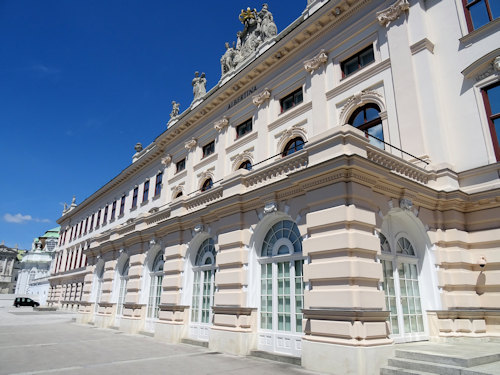
Wander into any supermarket in Vienna and you’ll see Teebutter (“tea butter”) in the dairy section. The origin of the name involves Austrian archduchesses and aristocratic finery.
Allegedly.
- Name derives from the quality butter produced by the historical Teschen ducal estates
- Except that explanation probably isn’t true
- Most likely origin is an association with the finery of English tea drinking
- See also:
Tea salons & dairy farms

(The Albertina palace, former home to aristocratic butter makers)
Habsburg Empress Maria Theresa (1717 – 1780) may have loved her husband, Franz Stephan, but she didn’t feel the need to allow her children the same privilege when it came to their choice of partner.
In fact, you can think of the Imperial children as chess pieces destined to shuffle around Europe, securing borders, power, and prestige through strategic marriages.
Maria Amala, for example, married Ferdinand, Duke of Parma.
Maria Karolina married Ferdinand, King of Naples and Sicily.
And Maria Antonia married Louis XIV of France (you’ll know her by her more famous name: Marie Antoinette).
There was one exception to the rule, though.
Archduchess Maria Christina (1742–1798) was her mother’s favourite, a position she exploited to gain permission to marry for love, rather than politics. Her eye had fallen on the willing heart of Prince Albert of Saxony, and the two married in 1766.
Part of the generous dowry Marie Christine brought into the marriage was the Duchy of Teschen in modern day Poland. A few inheritances later and this Duchy landed in the hands of Archduke Albrecht in 1847 and then his adopted son, Archduke Friedrich, in 1895.
Both archdukes developed the duchy’s dairy enterprises, producing extremely fine butter and other products that made the family rather wealthy. They labelled the butter as Teschner Erzherzögliche Butter or Teebutter for short.

(Friedrich of Österreich-Teschen: archduke, landowner, and maker of fine butter; photographed around 1900; Wien Museum Inv.-Nr. 188598/4; excerpt reproduced with permission under the terms of the CC0 licence)
It seems, then, that the expression Teebutter or tea butter (used today for quality butter) has nothing to do with the drink and all to do with the agricultural expertise of various aristocrats.
These Imperial origins for the Teebutter name certainly make a nice story, and it all sounds distinctly plausible.
Unfortunately, it’s all unlikely to be true. (Fake news, as we would probably say nowadays.)
Linguistic research suggests a more banal explanation.
Apparently, the English court imported fine Austrian butter for afternoon tea, perhaps leading to the use of the term tea butter as a mark of distinction.
Equally, the name may have come the other way, when a clever butter manufacturer used the term to associate their product with the noble English tradition of tea drinking, where only the finest butter was used for the accompanying bread.
The earliest reference I’ve seen myself is an advert in a Meraner Zeitung paper of 1877 for the confectioner Jos. Wagner in Vienna, who offered fresh Theebutter (sic) as well as such delights as French chocolate and bonbons.
We shall probably never know the real story. But you can visit Archduke Albrecht’s tea salon (Teesalon) in Vienna’s Albertina Palace. The riches his butter helped bring are amply demonstrated in the splendour of the palace staterooms.
P.S. If you ever tire of all the Viennese coffee houses and feel in need of some afternoon tea, you can always walk from the Albertina across to Kärntner Straße and down to Stephansplatz. Slip behind the cathedral to find the Haas&Haas tea rooms, complete with scones and cucumber sandwiches.